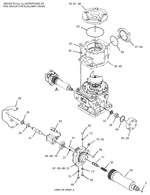Hello, i am dealing with strange problem on CAT 988K loader. Hydraulic pressure is low, but only on high idle. Specification is 330 bar, a can meet that on low idle, but when on high idle pressure drops to like 240 bar. We inspected the pump, seems fine. Checked main relieve valve, also seem fine, when i tighten it its responsive, pressure rises, but only on low idle. Tryed to tighten line relieves valves, also seems to have no effect. If you have any tip to try a would be very happy. Also i attached schematic for the machine.
Thank you guys.
Thank you guys.

